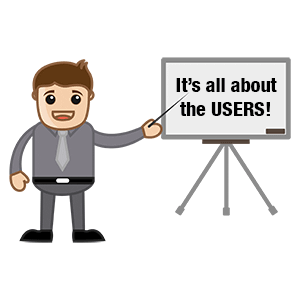When working with a client, one of the problems I see arise from time to time is an epic battle for website supremacy.┬á OK, I guess that’s a little over-dramatic. It’s not really on the same scale as world domination or some other sci-fi movie plot. It’s more of a quibble about different folks within an organization wanting to have the final say in their company’s website.
That’s not exactly a Star Wars type of battle. Even so, it can wreak havoc on the process of figuring out the look, layout and content of a new website. And that is kind of a big deal.
Whether an organization is large or small makes no difference here. Whenever you have more than one person with input into a website project, there are going to be some battles.
In some cases I have seen the head of an organization give up and just plain give in to everybody’s ideas. While that may make the team happy, it sure doesn’t do much for the website.
The Problem with Pleasing Everybody
Just like food pairings, ideas don’t always work together cohesively. Sometimes two good ideas are polar opposites of each other. That doesn’t stop some organizations from still trying to make them both work.
I love ice cream. I love pizza. But ice cream on top of my pizza? Good luck making that work. For one thing the ice cream would melt…but I digress.
This method of simply throwing every idea against the wall and seeing what sticks is bad for the user experience (UX) of your website. And it is that user experience which is going to make or break your website.
Users Come First, Egos Come in Last
 We all have egos to some degree. Nobody ever wants to hear that their idea is no good or that they haven’t done a good job. And so, I’m not recommending that anyone be treated that way.
We all have egos to some degree. Nobody ever wants to hear that their idea is no good or that they haven’t done a good job. And so, I’m not recommending that anyone be treated that way.
What I am suggesting is that, from the very start of the project, the leadership of the organization has to make it known that the user experience is the number one goal of the new website. An investment in the users is an investment in the success of the website.
And while I like to throw out a fancy term like “user experience”, that doesn’t necessarily mean it’s a complicated thing. In fact, much of it just comes down to common sense items, such as:
- Navigation that is easy to use
- Text that is easy to read (perhaps even the option for the user to increase the font size)
- Offering a mobile version of the site
- A content layout that flows nicely and logically leads users from one area to another
- Sharing buttons to allow users to spread your content via social media
- No ambiguous text or images
Pretty simple stuff. Yet, sometimes it takes someone from outside the organization to point this out (which I try to do when necessary). Remember, it’s all about creating a website that serves your customers┬áÔÇö not your ego.
